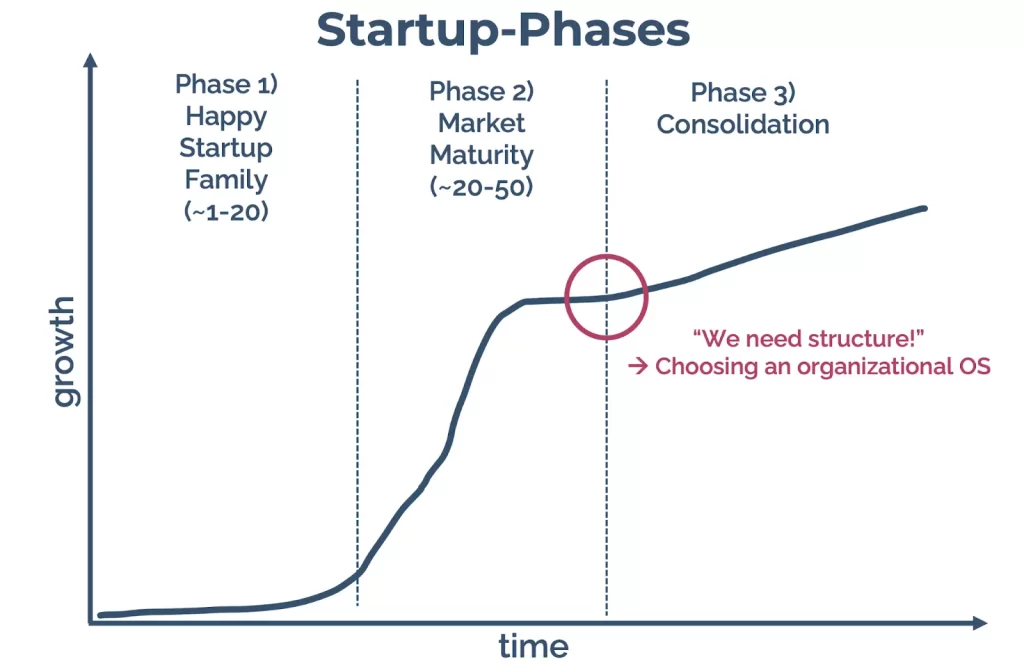
This article describes how startups can better respond to the need for more organizational structure by knowing real alternatives to conventional hierarchy, and when to make a deliberate operating system change.
For most startups, there are obvious stages in their development where fundamental decisions need to be made. In the beginning, founders may meet at university or get together with friends to explore a business idea. After a period of experimentation, those who do not fail in the early stages (which is most startups) will reach a stage where the product-market fit increases.
How do you know if this is already the case? Quite simply, the fact that this question is being asked at all means that the optimal market fit has certainly not yet been achieved. Because once it is, there is an unmistakable pull of the market that runs through the entire organization, ensuring that there is rapid growth to meet demand. Organizations in the growth phase are more likely to die of constipation than starvation. There are too many opportunities and there is a risk of biting off more than the organization can chew. The team needs to grow in a relatively short period of time to keep up with increasing demand.
“Help, we need structure!”
This is where startup founders enter a common dilemma: As the team grows, so does the complexity of the organization, and it becomes clear that some kind of intermediate hierarchy is structurally required. At the same time, this calls into question the basis of the company’s previous success, its agility, its interpersonal closeness and looseness, and the feeling of being part of a self-chosen family.
But not wanting to have a problem ultimately doesn’t solve it. “What the heck, in the end, we don’t have a choice anyway — so bring on the full-time leaders, managers, ‘head-of’s’, etc.”, you pragmatically tell yourself as a founder, and let fate take its course, while you swear to yourself that you will practice “servant leadership” and other lofty leadership ideals, and never let yourself be seduced by the dark side of power. Good luck!
A Choice That Is Not a Choice
Strictly speaking, the decision in favor of the classic management hierarchy is not really a decision, because a “decision” assumes that I can choose from at least two viable options. Letting the organization slide into hopeless chaos is not a viable option, however, and so most startups are left with the motto “close your eyes and get through it” and impose the unloved management hierarchy, with all its interpersonal entanglements, and hope that everything will work out in the end.
The good news is that there is in fact a viable alternative to the classic management hierarchy. It is called self-management.
The good news is that there is in fact a viable alternative to the classic management hierarchy — and therefore there is a real choice to be made, provided that one is aware of this alternative. It is called self-management, or self-organization, and it is gaining visibility in the mainstream. But unfortunately, the majority of companies are still relatively ignorant of this alternative or do not (yet) dare to break new ground.
A Real Alternative: Self-Management with Holacracy
The variant of self-management we favor at Xpreneurs is called Holacracy. It’s a robust peer-to-peer practice of distributed authority without traditional managers, developed in 2006 by Brian Robertson and the company HolacracyOne, and now practiced in thousands of organizations worldwide. The rules of this practice are codified in the “Holacracy Constitution.” The goal of this article is not to explain Holacracy (you can read about that elsewhere, like in the Holacracy blog), but to highlight the fact THAT a realistic alternative to the classical hierarchy does exist, for or against which one can make an actual meaningful decision. This makes the classical management hierarchy no longer without alternatives, and the decision a real choice between two viable options.
The Problem of the Right Timing
Assuming that Holacracy-style self-management is seen as the right choice, when should the alternative operating system be introduced in the organization? One can roughly distinguish three phases in a startup’s growth:
1) the naive early days when everyone is part of a Happy Startup Family;
2) the phase when the product-market fit has been optimized, leading to a growth spurt and increased complexity; and
3) a consolidation phase when the organization has to structurally digest its growth (if it doesn’t want to perish from constipation).

Phase 1: Happy Startup Family
In phase 1, there isn’t usually awareness that the growth spurt in phase 2 will come and lead to a need for structure. People think they can work together forever in the garage with friends as a Happy Family. Although it would be ideal to build the organization on a sustainable foundation with a Holacracy operating system at this early stage, other things are more likely to demand attention:
- Verify the hypothesis that the organization’s products are needed.
- Develop income streams to have a financial runway long enough to bring a product to market.
- Get the right people with the right skills on board.
In phase 1, the need for self-management is not high, because you are still working well with your colleagues at eye level (and all needed tasks are being done), and there are not usually enough financial resources to get thorough Holacracy training and professional mentoring (though there may be exceptions). So this is not usually the right time.
At the same time, there are substantial benefits being missed. As soon as the questions arise as to what work actually has to be done, who is accountable for what, and who makes what decisions, one would have the opportunity to make these decisions using Holacracy. Most startup founders unconsciously and unintentionally create a practice that will later harm the organization, and from which they have often tried to escape by, ironically, creating yet another company.
Phase 2: Market Maturity
Even in the market maturity phase (2), by definition a turbulent phase, a radical change in the organizational operating system is not recommended because such a change requires an investment of time and attention. However, this is not viable here, because the phone doesn’t stop ringing. In addition, the sudden increase in complexity only becomes noticeable toward the end of this growth phase, which means that the structural deficit will suddenly become acute. And so this is not usually an ideal time either.
But from another perspective, this is the first real stress test for the company. If you can already build on solid self-management practices from the early stages here, there will likely be significantly less collateral damage.
Phase 3: Consolidation
In phase 3, you have mastered the first rush of customers and recognized the need for structure. At this point, most founders choose the path of classic management hierarchy. But, as we have learned before, there are other paths available: it is also possible to follow the lead of a growing number of pioneering companies from all over the world in the direction of self-management. In phase 3, you have sufficient resources, you have a working product, and you know that a suitable organizational structure will not build itself. From this plateau, you can either passively drift along with the flow of traditional hierarchy, or you can completely rebuild your organization with self-management.
Conclusion
If you value startup qualities such as agility, decentralized decision-making, maximum autonomy, and working at eye level and want to scale, but don’t want to forgo role and process clarity, a consistent self-management system such as Holacracy is an option to seriously consider in the last consolidation phase.
However, if you consistently think ahead, you will consider the question of system selection from the very beginning, because it will inevitably arise on its own. The earlier you practice alternatives, the easier it is to establish a new pattern of collaboration that can ultimately withstand changes in the organization (e.g., consultants, new colleagues, VCs) — without responding purely reactively to the need for structure by establishing a management hierarchy because “that’s just how a professional organization works.”
To the contrary, the traditional management hierarchy is not a fate that one has to endure. But you can only make a real decision when you know real alternatives.
To learn more about self-management, join a community of pioneers and check out our e-learning suite → Self-Management Accelerator